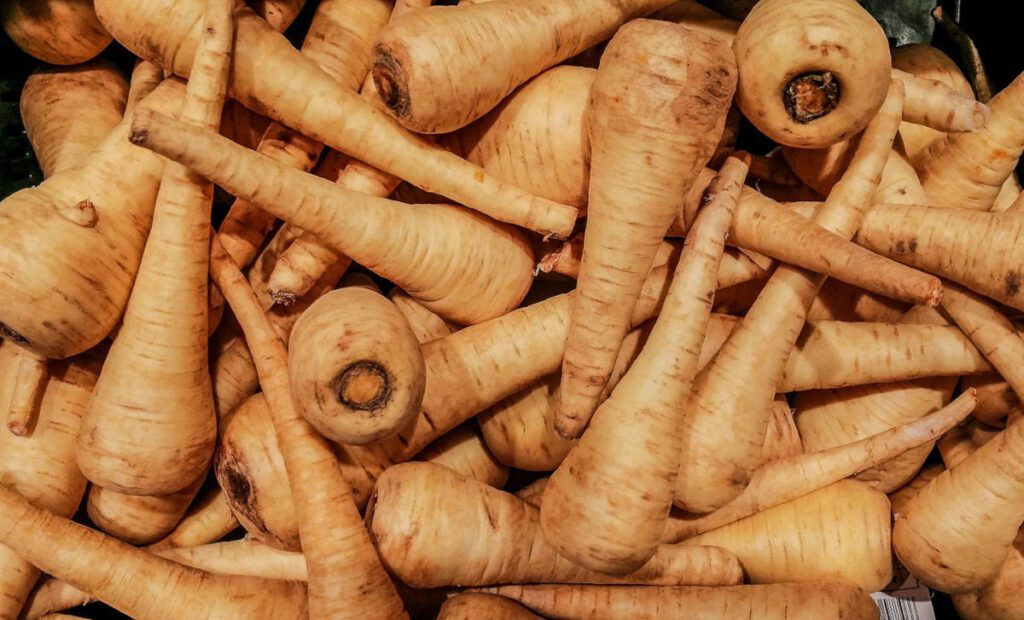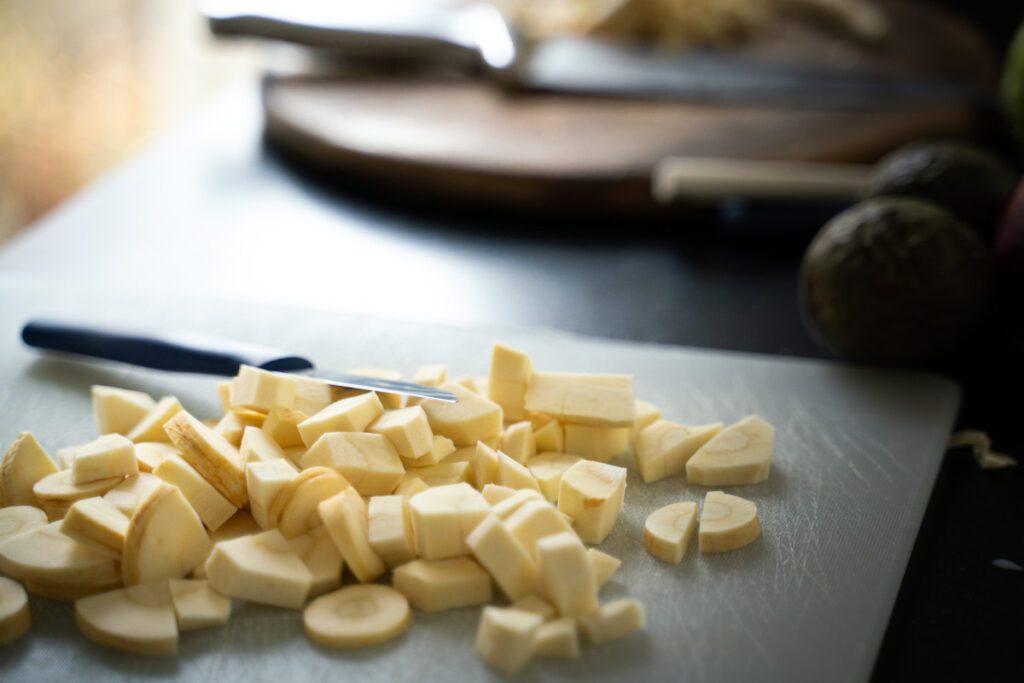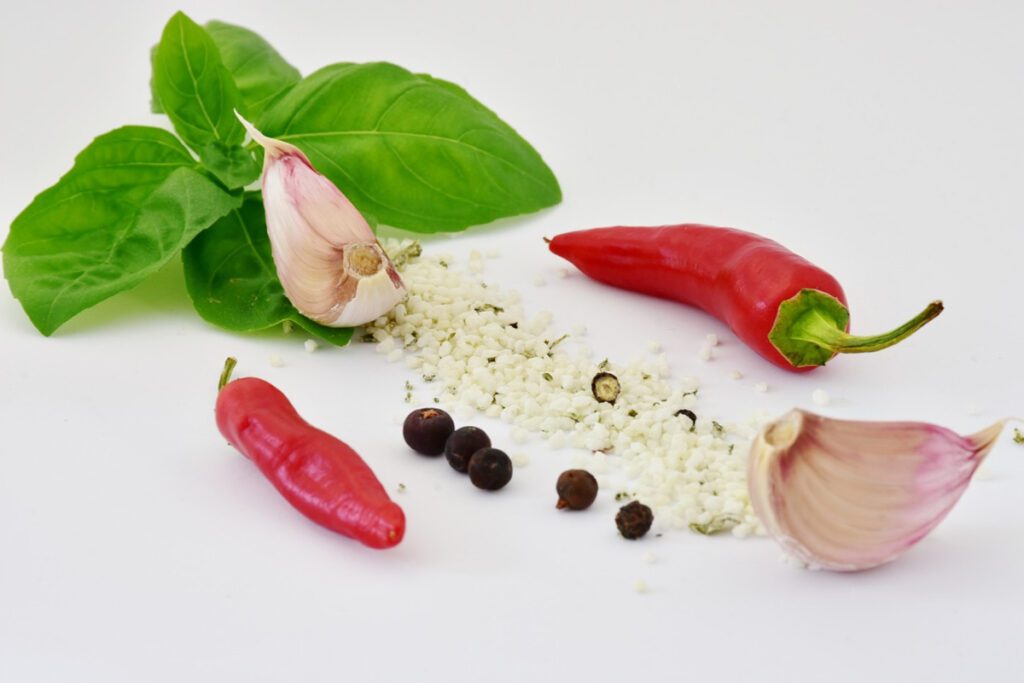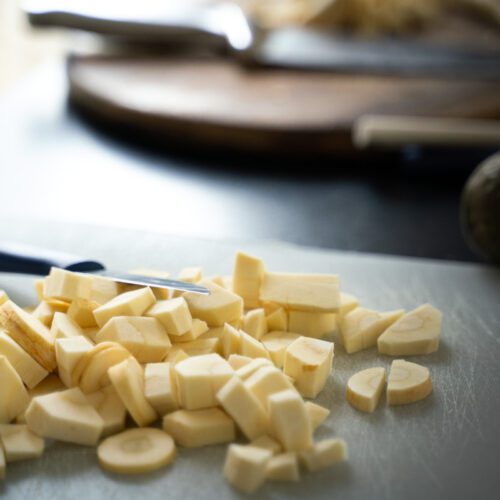Looking for a delicious and unique condiment to spice up your meals? Look no further than parsnip chutney! This flavourful chutney is the perfect accompaniment to a wide range of dishes. Made with fresh parsnips, aromatic spices, and a touch of sweetness, this condiment is sure to become a favourite in your kitchen. Give it a try and take your taste buds on an adventure.

Why make parsnip chutney
Making parsnip chutney is a great way to add an exciting new flavour to your cooking!
I enjoy roasted parsnips and can have them any time of the year.
So when I came across parsnip chutney at a farm shop when visiting friends, I had to give it a try. Not only was it a new taste experience, but I discovered another way to enjoy parsnips – winner! Recipes for parsnip chutney were not easy to find. But with perseverance, adapting a recipe for carrot chutney and some creative flavouring, a tasty chutney was born.
Be adventurous and give it a try. This chutney is easy to make, but it’s also incredibly versatile. You can use it as a condiment on anything from roasted meats to sandwiches. Plus, with its delicious combination of fresh parsnips and aromatic spices, you’re sure to impress your family and friends with this tasty treat.
How to make this chutney
Making parsnip chutney is a satisfying and delicious process that takes the humble, often side-lined, parsnip and turns it into a flavourful condiment.

To begin, fresh parsnips are peeled and then diced into small cubes. Cooking apple is added as a good pairing flavour and effective thickener.
Aromatic spices are added to the mix to create a flavourful seasoning blend. Raisins add pops of sweetness and texture.
Finally, the mixture is simmered in vinegar until thick and jam-like.
Once your parsnip chutney is ready, try it out with all sorts of dishes.
TIPS for a delicious parsnip chutney
1. Choose good quality, fresh parsnips for the best flavour. Avoid parsnips that are discoloured or soft. You need firm fresh vegetables for this recipe.
If you need to store them, wrap them in dampened kitchen paper and then in foil before storing them in the vegetable compartment of your fridge. This should maintain firmness for up to 48 hours. They can otherwise dry out and soften quite quickly.
2. Dice the parsnips and apple into small cubes for a consistent texture in your chutney. This also helps the mixture to cook evenly.
3. Simmer the mixture until thick and jam-like. Making chutney is about taking things nice and slow so that the flavours intensify and you realise a lovely thickened consistency. Once you can draw a wooden spoon through the mixture and it leaves a clear train behind, it is ready to be ladled into jars.
4. Let the chutney rest in a cool, dark place for at least 4-6 weeks to allow the flavours to blend and mellow for maximum deliciousness!
Flavour suggestions for your chutney
- Add additional spices like cardamom, cumin or cinnamon to create a unique flavour profile. Herbs like coriander and rosemary can take it in another direction. The base flavour of parsnips lends itself well to blending with your favourite spices.
- Adjust the sweetness level by adding honey or more sugar to suit your taste.
- Add chopped nuts or consider other dried fruits such as currants or chopped dates for texture and extra flavour.
- Choose a different vinegar for a different taste note. A fruit vinegar or red/white wine vinegar. Ensure that whichever vinegar you choose that it has a minimum of 5% acetic acid to support the preserving role of this ingredient.

- Make it hot, hot, hot – add fresh chilli or chilli flakes and take this otherwise sedate vegetable to another level. Parsnips like you have not known them before!
- Add some complementary fruits or vegetables e.g. pears or carrots for a more adventurous ingredient blend.
Ways to enjoy a parsnip chutney
1. Serve this chutney as a condiment alongside grilled meats or on sandwiches.
2. Use it to add some extra flavour to salad dressings or roasted vegetables.
3. Mix the chutney with cream cheese for a delicious spread on crackers and bread. Or to use as a dip for vegetables, crisps or fries.
4. Add spoonfuls of the spicy parsnip deliciousness to soups and stews for an easy way to elevate a meal.
Making parsnip chutney is a great way to add an exciting new flavour to your cooking. Plus, with the help of this recipe along with some tips for enjoying and customising this tasty treat, you’ll be able to make something that will surprise and delight your family or friends in no time. So why not serve parsnips up in a new and delicious way today?

Recipe for Parsnip Chutney
Equipment
- Kitchen scales
- Chopping board and knife
- Preserving pan or large saucepan
- Long-handled spoon for stirring
- Ladle
- Jam Funnel
- Clean, sterilised glass jars with sealable lids
Ingredients
- 500 g parsnips
- 250 g apples
- 150 g shallots
- 100 g raisins
- 400 ml apple cider vinegar
- 1 tbsp oil
- 300 g brown sugar
- 1½ tsp ginger
- 6 whole cloves
- ½ tsp mustard seeds
- ½ tsp salt
Instructions
- Wash and drip-dry the parsnips and apples.
- Peel the parsnips and apples. Remove the apple cores. Chop the parsnips and apples into roughly the same-sized pieces for even cooking. Set aside.
- Peel and chop the shallots.
- Add the oil and chopped shallots to the preserving pan and heat to start to soften the onions.
- Once the onions are softened, add the chopped parsnips, apple, raisins, spices, salt and sugar to the pan and stir well.
- Add the vinegar, stir and turn up the heat. Keep stirring to encourage the sugar to dissolve completely.
- Bring the mixture to a boil, then reduce the heat to a simmer. Stir from time to time.
- Once the mixture has thickened and a spoon drawn through it leaves a clear trough, it is ready to be potted up.
- Ladle the hot spicy chutney into the sterilised jars, using the jam funnel to limit spills.
- Leave a headspace of around 1cm at the top of the jars, and seal them with vinegar-proof(non-reactive) lids.
- Leave the chutney to cool completely at room temperature.
- Label the jars and store them in a cool, dark place.
- As with most chutneys, giving it some time (4-6 weeks) to mature and mellow results in an overall better flavour experience.The chutney should keep for 6 months.
Notes
TIPS for a delicious parsnip chutney
1. Choose good quality, fresh parsnips for the best flavour. Avoid parsnips that are discoloured or soft. You need firm fresh vegetables for this recipe. If you need to store them, wrap them in dampened kitchen paper and then in foil before storing them in the vegetable compartment of your fridge. This should maintain firmness for up to 48 hours. They can otherwise dry out and soften quite quickly. 2. Dice the parsnips and apple into small cubes for a consistent texture in your chutney. This also helps the mixture to cook evenly. 3. Simmer the mixture until thick and jam-like. Making chutney is about taking things nice and slow so that the flavours intensify and you realise a lovely thickened consistency. Once you can draw a wooden spoon through the mixture and it leaves a clear train behind, it is ready to be ladled into jars. 4. Let the chutney rest in a cool, dark place for at least 4-6 weeks to allow the flavours to blend and mellow for maximum deliciousness!Flavour suggestions for your chutney
- Add additional spices like cardamom, cumin or cinnamon to create a unique flavour profile. Herbs like coriander and rosemary can take it in another direction. The base flavour of parsnips lends itself well to blending with your favourite spices.
- Adjust the sweetness level by adding honey or more sugar to suit your taste.
- Add chopped nuts or consider other dried fruits such as currants or chopped dates for texture and extra flavour.
- Choose a different vinegar for a different taste note. A fruit vinegar or red/white wine vinegar. Ensure that whichever vinegar you choose that it has a minimum of 5% acetic acid to support the preserving role of this ingredient.
- Make it hot, hot, hot – add fresh chilli or chilli flakes and take this otherwise sedate vegetable to another level. Parsnips like you have not known them before!
- Add some complementary fruits or vegetables e.g. pears or carrots for a more adventurous ingredient blend.
Ways to enjoy a parsnip chutney
1. Serve this chutney as a condiment alongside grilled meats or on sandwiches. 2. Use it to add some extra flavour to salad dressings or roasted vegetables. 3. Mix the chutney with cream cheese for a delicious spread on crackers and bread. Or to use as a dip for vegetables, crisps or fries. 4. Add spoonfuls of the spicy parsnip deliciousness to soups and stews for an easy way to elevate a meal.Nutrition
Nutritional Disclaimer
All nutritional information is an estimate only, based on third-party calculations derived from an online nutritional calculator, Spoonacular API. The data provided is a courtesy and should not be considered a guarantee or fact. Each recipe and nutritional value will vary depending on the ingredients and brands you use, your measuring methods and portion sizes. For accurate results, we recommend that you calculate the nutritional information yourself, using a preferred nutritional calculator or advice from a nutritionist, based on your ingredients and individual processes.